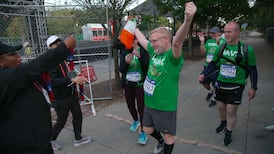THE COFFIN lay open. The mourners approached one by one.
Some spat their contempt and turned away swiftly. Others reached inside the grand, silver casket and kept a hand there for a moment as if trying to purge the years of terrible memories and suffering. Each left a handwritten note.
“Since this is a church, I’m going to be nice,” said one. “You made me lose my home. You may have taken away my life as I know it but you’ll never take away my spirit.” Another said: “Thank God you are gone but unfortunately you will never be forgotten.”
The congregation had gathered to bury Hurricane Katrina five years after it smashed through New Orleans’ inadequate levees, flooded most of the city and erased entire communities. About 1,800 died and more than a million fled, many never to return.
Tens of thousands are still living in trailers scattered across neighbouring Texas and beyond. Many of those who did come back faced desolation, the destruction of their homes, the loss of their jobs.
The Catholic archbishop of New Orleans, Gregory Aymond, said the symbolic funeral would lay to rest “the hurt, the pain, the woundedness, the hopelessness”.
Five years on, the government has spent $143 billion (€112 billion) on the reconstruction of public buildings and private homes, roads and bridges, in one of the largest programmes of its kind in US history. But the anger of the notes dropped into the coffin echoes across large areas of a city that has recovered so completely in parts that the only evidence of Katrina is how often it still comes up in conversation.
The money-spinning French Quarter is again busy with tourists, and white southern gentlemen in Panama hats and bow ties populate the restaurants of the smarter ends of town as if nothing ever happened.
Then there is Ventura Drive, a few blocks from Katrina’s funeral in St Bernard parish. House number 3112 stands almost alone. There is a compulsory demolition notice taped to the window. There is no 3110 or 3114.
The blocks to the left and right, in front and behind have been wiped of all sign of the homes that once stood there. More than onethird of the population of St Bernard has still not returned.
Across the administrative line in the neighbouring Lower Ninth, the predominantly working-class African American district that bore the worst of the disaster, just one in four residents has moved back. One is Henry Irvin, whose house sits virtually alone on St Louis Avenue.
“The house next door had almost blown on top of mine but it didn’t. But my house did fill with water, covered with water. Everything inside was destroyed. All my personal stuff,” he said. “Volunteers gutted my house out. We had to air it out and then we had to rebuild. New insulation, new electrics, new everything.” Irvin (74) fled the day before the storm. For the next three years he moved around, living with relatives and in a trailer provided by the authorities. Finally he moved back home in 2008.
“I was just trying to hurry up and get home because there was nothing like living in that damn trailer. Most of my neighbours are gone. In my square I’m the only house. All around are empty lots. Turn the corner and there’s nothing there but grass and trees,” he said. “There was a time when everybody around here knew everybody. It changed. There’s not the people, not the community. Perhaps they can change it for the better, but they’ve got to give us a fair share of the pie. There’s a lot of people all the way to Texas that want to come back home but they can’t because they can’t afford to rebuild or bring their kids back here because we don’t have the schools. They give the grants to the people with the big houses.”
Irvin, like many residents of the Lower Ninth, thinks the city does not want the residents back. “It’s racism. We’ve been suffering from racism down here for many, many years,” he said. “There are some who want to run us all out of here. Some big people in this town are trying to buy all that land and make it a green space with motels and gambling and casinos.”
It is a common view in the Lower Ninth, though it has been dismissed by state and city leaders. But earlier this month, a federal judge ruled that the criteria for awarding grants to rebuild discriminated against black people.
The Louisiana state government offers up to $150,000 (€118,000) for people to reconstruct their homes, but applicants are not permitted to claim for more than the pre-hurricane value of their properties, no matter that the cost of repairing or replacing a house is similar city-wide. Those living in the Lower Ninth, where property values were the lowest in New Orleans, have been hit hardest by the rule.
The hurricane is often spoken of not as a passing disaster but as a living entity. People say “she” not “it”. Joey DiFatta, chairman of the local council at the time the hurricane struck, declared at the symbolic funeral: “Today we’re burying this witch.” – (Guardian service)








